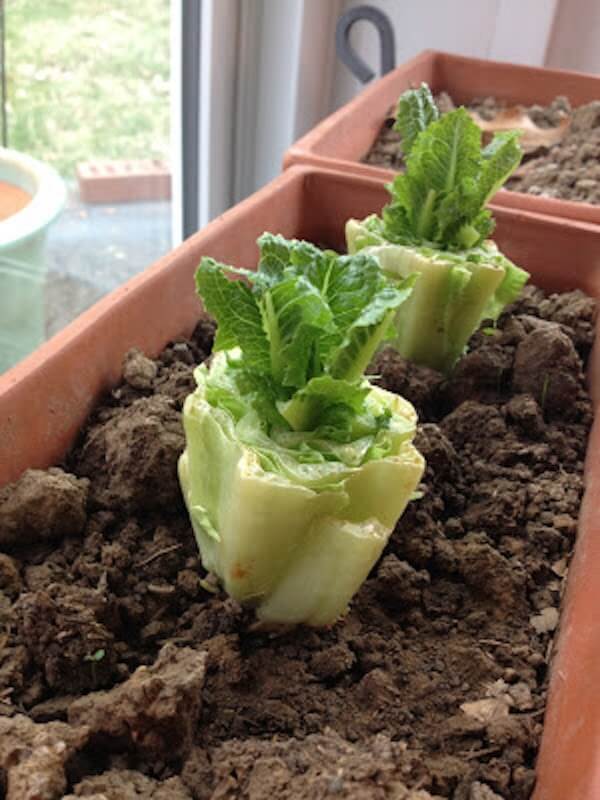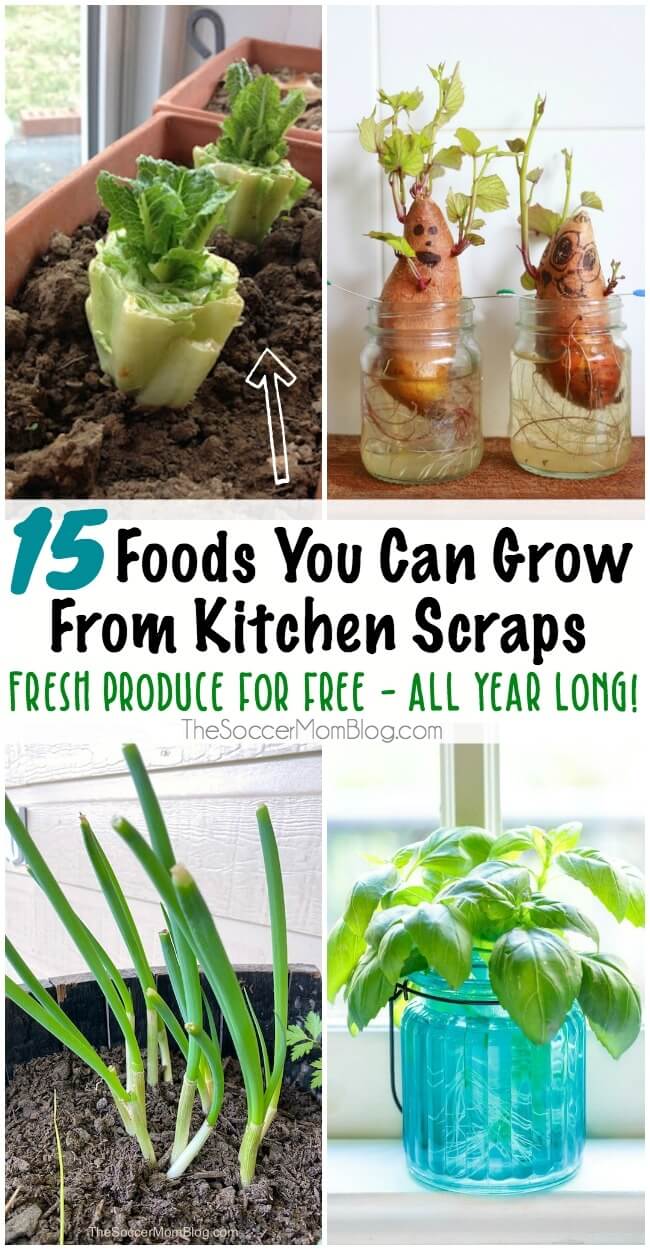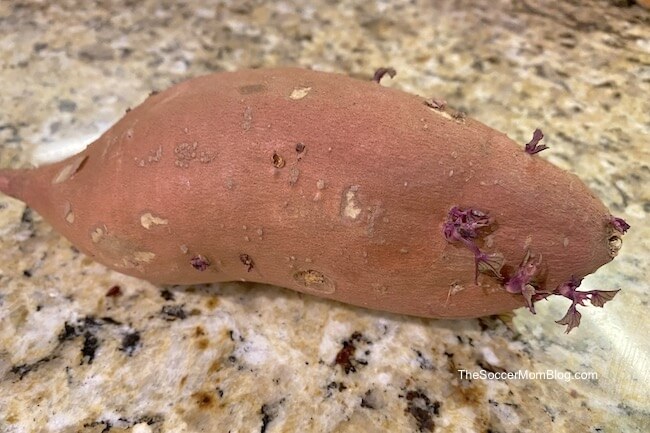Don’t throw away those old potatoes! Or those romaine lettuce ends! There are lots of foods you can regrow from scraps — it’s easy, free, and you don’t need a lot of space! Keep reading for a list of 15 plants to grow from scraps to keep fresh produce ready all year long!
I’ve never considered myself to have a green thumb. In fact, I’m pretty notorious in my family for just the opposite!
However, when my husband and I moved our family to a small homestead on 5 acres, there were three large raised bed gardens on the property already. I figured since there was already space there, it couldn’t hurt to give gardening another try.
The first thing I planted was kale — and those kale plants grew like weeds! How excited to be able to grow your own food instead of spending money on pricey kale at the grocery store!
Can You Regrow Vegetables from Scraps?
Inspired by my success with the kale, I decided to keep going with my gardening experiment. In addition to seeds and starter plants, I looked for plants to grow from scraps.
Some were pretty self explanatory, like the green onions that I planted in the space around my kale. Those were as easy as sticking the roots/bulbs in the dirt!
I also found tutorials online which gave me ideas for which kitchen scraps you can regrow. I can’t wait to grow some romaine lettuce so we can have salads all summer!
What Do You Need to Regrow Scraps into Plants?
For your convenience, I’ve provided shop-able ad links to products used to make this natural ant repellent spray; read our disclosure policy here.
Since the whole point of regrowing kitchen scraps is to avoid spending a lot of money, it defeats the purpose to spend a lot on supplies.
However, you may need some things to get started:
- Potting soil or gardening soil — The soil in the ground might not be ideal or nutritious enough to grow thriving veggies. If you don’t compost and make your own soil, I’d recommend buying gardening soil to establish your garden. I watch for sales on dirt and then stock up!
- Pots — though you can recycle and upcycle any type of containers you have on hand! I made a container garden out of an old wooden wagon!
- Garden trowel and/or shovel — I love my serrated edge digger because in addition to digging and planting, I can use it to cut roots or rip open bags of soil!
15 Edible Plants to Regrow from Scraps
This is a list of foods you can regrow from scraps — things we’ve already planted successfully and a few that are on our list for the weeks ahead.
1. Green Onion
It is extremely easy to regrow green onions from scraps — you don’t need a green thumb at all!
The next time you buy a bunch of green onions, keep the bulb end after you’ve used all the stalks. Plant the bulbs in a pot or container garden so that the top of the stalk pokes out of the dirt.
That’s it!
Green onions grow quickly, and within a couple days you’ll see new green shoots. Once they’re about six inches long, you can simply trim the shoots as needed and leave the bulbs in the ground. They’ll keep producing green onion stalks over and over!
2. Kale
Unless you already have kale planted, you’ll need to start with seeds or a small planter. However, once your kale is in the ground it will keep producing leaves for months and months!
Once your kale plants are mature, clip off leaves as needed, starting with the larger leaves at the bottom of the stem. As long as you leave a handful of leaves attached near the top, your kale will keep making new ones!
Kale was the first thing I planted in our new garden, as it can be planted in the fall and actually thrives in cooler weather. With 6 plants, we have enough kale to cook at least 2-3 times a week and we’ve given family and friends bagfuls!
3. Leeks
Regrowing leeks works just like regrowing green onions. Save bulbs with at least an inch or two of the stalk. Plant the bulbs in the ground with the stalk peeking out and they will regrow!
As you can see from the photo above, our leeks are ready to harvest!
4. Basil

Image Credit: The Café Sucre Farine
The next time you purchase fresh basil or visit a pho restaurant, save a sprig of basil! Cut the stem, keeping a few leaves attached. Place in a jar of water to generate roots, then you can move to a planter.
5. Garlic
To regrow garlic, you can start with individual cloves or a whole head of garlic. Simply bury the cloves under about an inch of soil and keep watered.
The garlic is ready to harvest when it starts to turn yellow.
6. Potatoes
When potatoes start to sprout, they’re no longer good to eat. But why throw them away when you can use them to grow more potatoes…for free!
To regrow potatoes, cut a sprouting potato into chunks, so that each chunk has an eye and a sprout. Plant with the eye facing up and cover with a few inches of dirt.
Keep watered and in a few weeks those potato pieces will start to sprout and grow full sized potatoes!
7. Romaine Lettuce

Image credit: Fast, Cheap and Good
When you cut the leaves off a head of romaine lettuce, keep the end! You can plant this in soil, water, and it will start to regrow leaves.
Similar to kale, you can clip the leaves as needed and your romaine plant will grow more!
Since we love our regenerating kale plants so much, romaine lettuce is next one our list to try!
8. Bok Choy
Bok Choy can be regrown just like romaine lettuce!
9. Celery

Image credit: 17 Apart
Celery can be regrown by saving the base and placing in a cup of water until leaves sprout. At that point, you can transfer the celery plant to a pot with soil.
In a few weeks the stalks will grow taller and thicker and soon be ready to enjoy!
10. Cilantro
Like basil, cilantro can be regrown from cuttings, though not quite as easily. However, once you have a mature cilantro plant, you can cut leaves as needed and it will keep on growing!
11. Rosemary
Rosemary can be regrown by cutting a 3″ piece from a mature plant. Strip the leaves from the bottom half of the cutting and plant that end in soil.
It’s recommended to start in a small planter, keeping the cuttings moist and with indirect sunlight, until the begin to take root and grow. At that point you can transplant to their final location.
12. Onion

Image Credit: The Gardening Cook
The next time you cook with onions, save the bottom piece of the onion that contains the roots! This one piece of onion can be sprouted and used to re-grow two or more onions!
To grow a full-sized onion bulb can take 3-4 months. Or you can clip the greenery from the onion and use that!
13. Sweet Potato
Sweet potatoes are grown a little differently than regular potatoes. Instead of planting the potato itself, to regrow sweet potatoes you plant the sprouts, also known as “slips.”
You can start with a sprouting sweet potato like this one:
Or you can purposely sprout your own. Place it in a jar of water to grow the slips. Once they’re about 5 inches long, twist the slips and pull them out of the potato. Now you can plant the slips in the dirt – about halfway deep.

Image Credit: Little Eco Footprints
The really cool thing is that you can keep growing countless slips from one single potato!
14. Ginger
Regrowing ginger from scraps is easy and your ginger root will continue producing as long as you take care of it!
Simply plant a piece of ginger root in a pot with soil, water, and wait for it to sprout. After a few weeks, your ginger root will grow so that you can begin harvesting small pieces as needed.
When you’d like to get a piece of ginger, push the dirt away until the root is visible, cut a piece off, and leave the rest planted. Recover any cut area with dirt so it can regrow.
15. Mint
Growing up in West Virginia, we had a huge mint plant in our yard. I loved it and that was one of the first things I wanted to plant in our new home!
I bought a small mint plant from the grocery store for a couple bucks — I think it was intended for an indoor herb garden. However, in my raised beds, the mint thrived, just as I hoped!
Mint is a fairly easy plant to grow and spreads quickly on its own. However, you can regrow mint cuttings as you would basil and start new plants as needed.
You can also take fresh mint cuttings from the grocery store and grow roots in water, then plant in soil.
Your Turn!
Do you have anything you’d add to our list of foods you can regrow from scraps? Have you tried regrowing any other plants successfully? I’d love to hear your tips in the comments!
You might also like:
How to Make a Homemade Cloth Face Mask from a T-Shirt
DIY Ant Killer – Safe for Use in Homes with Kids and Pets!
Homemade Itch Relief Spray for Bug Bites
- Amish Sugar Cookies - April 19, 2024
- Marshmallow Playdough - April 18, 2024
- Homemade Fruit Leather Recipe - April 17, 2024













gwen says
thank you these tips were awesome
Annelien Nel says
Thanks Stacey, I am inspired to start my own veggie garden right away!
Karen Cales says
Thanks for your info I have a greenhouse and raised plants past two years Presently I have three celery plants started. Have sold sweet potato plants using water to start slips. I plan to start trying some of the other fifteen ideas. People were amazed at my celery plants and several are starting there own. I hope more people will get into growing there own plants this way. Thanks for your blog. Karen in WV.
Stacey aka the Soccer Mom says
Hi Karen – Isn’t it fun to regrow things? They already have a head start! I grew up in WV and I miss it so much! Texas is nice…but it’s HOT (and tough on plants) and no beautiful mountains!
Jacqueline says
Texas is hot. And the best place to live, bar none. Maybe you will appreciate all it’s beauty someday.
Stacey aka the Soccer Mom says
Texas is where I met my husband, so I’ll always be grateful for that! But I am from West Virginia and it’s hard to convince me that there is anywhere more beautiful 😉
Alex says
Texas is big! Some parts are beautiful…others not so much 😉 it’s just part of being so big!
nangobi phoebe says
Thanks for the tips I’m going to pass on these tips to my young nurses to support them in saving money
Linda says
Thanks, very informative and direct, love the simplicity with which you share.
Linda
Brinda says
Can you grow carrots from carrots?
Stacey aka the Soccer Mom says
You can re-grow the carrot tops/leaves, which are edible. However you won’t be able to re-grow the carrot itself.
Ana Julia says
Same for beets. Thanks Stacey for these wonderful tips. I’m so excited.
Michelle says
I’m surprised you didn’t have pineapple on this list. It’s super easy to regrow by replanting the top. First, you get roots to sprout by suspending it in water with the green leaves just above the water line. It’ll grow a whole new plant and that plant will make make a new pineapple and a new baby plant. They are slow growers, but the first pineapple that I grew was by far the best tasting pineapple I have ever had. There was no going back to canned pineapple after that.
Stacey aka the Soccer Mom says
My MIL used to regrow pineapples — they take a long time though! I’m impatient 😉
Addie N. Olivera says
I recently discovered that you can regrow turnips by keeping the leafy top! I just put them in water & the greens started growing pretty quickly, I’m going to move them into our raised beds & see what happens!
Stacey aka the Soccer Mom says
Will have to try that too!
Lindsay says
This is amazing and just the list I came looking for! Thank you!
Jeanie Miller says
Great ideas! I’ve seen videos claiming a halved pepper with the seeds included can grow.
I have also planted a tasty over ripe tomato to regrow the same verity the following year, works great. It will require thinning though.
Stacey aka the Soccer Mom says
Thanks for the reminder! I got lots of tomato plants from my compost pile this year! Just transplanted them right to my garden! Will have to update the post eventually.
Marge Roberts says
I have tried most of your suggestions but not celery. I’ve also put the top of a carrot in water. It grows lovely greenery but no roots or carrots! Maybe I should just plant it and see what happens.
Stacey aka the Soccer Mom says
Carrots will only grow the greens back — they can be good sautéed, or you can incorporate in things like pesto or chimichurri.
Pauline says
I find some of your suggestions a little difficult.
Green Onions – what is the point of not using the white parts – that is part of the flavor – and why not just grow chives – they multiply like crazy
Leeks – the same thing – as a matter of fact many of the recipes I see call for the bulb portion.
Reason for growing carrots would be for the “root” portion – not the greens – I presume that this would also pertain to beets
Sorry to be so negative.
I have had great luck with celery and romaine but it takes quite a while for the celery to produce stalks that can be used.
Paulie says
Cabbages ( any type) can be grown from the base. I uncut around the base when slicing a whole cabbage and then place the core in a shallow dish of water until small leaves start to grow, then plant outside. You won’t generally get a whole big cabbage, but you should get smallish ones or even multiple heads the size of large Brussels sprouts.
Stacey aka the Soccer Mom says
Yep! I do this and feed the new leaves to my chickens (because sometimes the re-growth is kind of tough)
Carma Perot says
i am just getting started on my little garden. This is valuable info.
I am 81 years old and my memory has gone away.